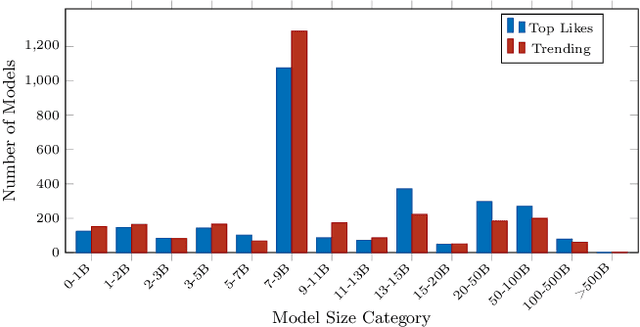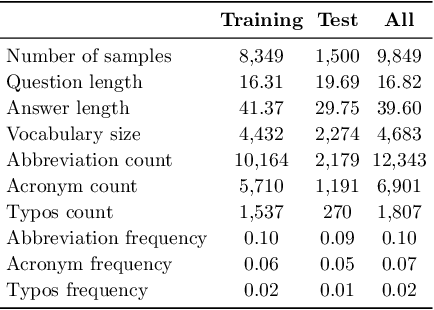Topic
Papers and Code
MELAC: Massive Evaluation of Large Language Models with Alignment of Culture in Persian Language
Aug 01, 2025As large language models (LLMs) become increasingly embedded in our daily lives, evaluating their quality and reliability across diverse contexts has become essential. While comprehensive benchmarks exist for assessing LLM performance in English, there remains a significant gap in evaluation resources for other languages. Moreover, because most LLMs are trained primarily on data rooted in European and American cultures, they often lack familiarity with non-Western cultural contexts. To address this limitation, our study focuses on the Persian language and Iranian culture. We introduce 19 new evaluation datasets specifically designed to assess LLMs on topics such as Iranian law, Persian grammar, Persian idioms, and university entrance exams. Using these datasets, we benchmarked 41 prominent LLMs, aiming to bridge the existing cultural and linguistic evaluation gap in the field.
Oedipus and the Sphinx: Benchmarking and Improving Visual Language Models for Complex Graphic Reasoning
Aug 01, 2025Evaluating the performance of visual language models (VLMs) in graphic reasoning tasks has become an important research topic. However, VLMs still show obvious deficiencies in simulating human-level graphic reasoning capabilities, especially in complex graphic reasoning and abstract problem solving, which are less studied and existing studies only focus on simple graphics. To evaluate the performance of VLMs in complex graphic reasoning, we propose ReasonBench, the first evaluation benchmark focused on structured graphic reasoning tasks, which includes 1,613 questions from real-world intelligence tests. ReasonBench covers reasoning dimensions related to location, attribute, quantity, and multi-element tasks, providing a comprehensive evaluation of the performance of VLMs in spatial, relational, and abstract reasoning capabilities. We benchmark 11 mainstream VLMs (including closed-source and open-source models) and reveal significant limitations of current models. Based on these findings, we propose a dual optimization strategy: Diagrammatic Reasoning Chain (DiaCoT) enhances the interpretability of reasoning by decomposing layers, and ReasonTune enhances the task adaptability of model reasoning through training, all of which improves VLM performance by 33.5\%. All experimental data and code are in the repository: https://huggingface.co/datasets/cistine/ReasonBench.
Demo: TOSense -- What Did You Just Agree to?
Aug 01, 2025Online services often require users to agree to lengthy and obscure Terms of Service (ToS), leading to information asymmetry and legal risks. This paper proposes TOSense-a Chrome extension that allows users to ask questions about ToS in natural language and get concise answers in real time. The system combines (i) a crawler "tos-crawl" that automatically extracts ToS content, and (ii) a lightweight large language model pipeline: MiniLM for semantic retrieval and BART-encoder for answer relevance verification. To avoid expensive manual annotation, we present a novel Question Answering Evaluation Pipeline (QEP) that generates synthetic questions and verifies the correctness of answers using clustered topic matching. Experiments on five major platforms, Apple, Google, X (formerly Twitter), Microsoft, and Netflix, show the effectiveness of TOSense (with up to 44.5% accuracy) across varying number of topic clusters. During the demonstration, we will showcase TOSense in action. Attendees will be able to experience seamless extraction, interactive question answering, and instant indexing of new sites.
GHTM: A Graph based Hybrid Topic Modeling Approach in Low-Resource Bengali Language
Aug 01, 2025Topic modeling is a Natural Language Processing (NLP) technique that is used to identify latent themes and extract topics from text corpora by grouping similar documents based on their most significant keywords. Although widely researched in English, topic modeling remains understudied in Bengali due to its morphological complexity, lack of adequate resources and initiatives. In this contribution, a novel Graph Convolutional Network (GCN) based model called GHTM (Graph-Based Hybrid Topic Model) is proposed. This model represents input vectors of documents as nodes in the graph, which GCN uses to produce semantically rich embeddings. The embeddings are then decomposed using Non-negative Matrix Factorization (NMF) to get the topical representations of the underlying themes of the text corpus. This study compares the proposed model against a wide range of Bengali topic modeling techniques, from traditional methods such as LDA, LSA, and NMF to contemporary frameworks such as BERTopic and Top2Vec on three Bengali datasets. The experimental results demonstrate the effectiveness of the proposed model by outperforming other models in topic coherence and diversity. In addition, we introduce a novel Bengali dataset called "NCTBText" sourced from Bengali textbook materials to enrich and diversify the predominantly newspaper-centric Bengali corpora.
Experimental Evaluation of Dynamic Topic Modeling Algorithms
Aug 01, 2025The amount of text generated daily on social media is gigantic and analyzing this text is useful for many purposes. To understand what lies beneath a huge amount of text, we need dependable and effective computing techniques from self-powered topic models. Nevertheless, there are currently relatively few thorough quantitative comparisons between these models. In this study, we compare these models and propose an assessment metric that documents how the topics change in time.
Watch the Weights: Unsupervised monitoring and control of fine-tuned LLMs
Jul 31, 2025The releases of powerful open-weight large language models (LLMs) are often not accompanied by access to their full training data. Existing interpretability methods, particularly those based on activations, often require or assume distributionally similar data. This is a significant limitation when detecting and defending against novel potential threats like backdoors, which are by definition out-of-distribution. In this work, we introduce a new method for understanding, monitoring and controlling fine-tuned LLMs that interprets weights, rather than activations, thereby side stepping the need for data that is distributionally similar to the unknown training data. We demonstrate that the top singular vectors of the weight difference between a fine-tuned model and its base model correspond to newly acquired behaviors. By monitoring the cosine similarity of activations along these directions, we can detect salient behaviors introduced during fine-tuning with high precision. For backdoored models that bypasses safety mechanisms when a secret trigger is present, our method stops up to 100% of attacks with a false positive rate below 1.2%. For models that have undergone unlearning, we detect inference on erased topics with accuracy up to 95.42% and can even steer the model to recover "unlearned" information. Besides monitoring, our method also shows potential for pre-deployment model auditing: by analyzing commercial instruction-tuned models (OLMo, Llama, Qwen), we are able to uncover model-specific fine-tuning focus including marketing strategies and Midjourney prompt generation. Our implementation can be found at https://github.com/fjzzq2002/WeightWatch.
Geometry of nonlinear forecast reconciliation
Jul 30, 2025Forecast reconciliation, an ex-post technique applied to forecasts that must satisfy constraints, has been a prominent topic in the forecasting literature over the past two decades. Recently, several efforts have sought to extend reconciliation methods to the probabilistic settings. Nevertheless, formal theorems demonstrating error reduction in nonlinear contexts, analogous to those presented in Panagiotelis et al.(2021), are still lacking. This paper addresses that gap by establishing such theorems for various classes of nonlinear hypersurfaces and vector-valued functions. Specifically, we derive an exact analog of Theorem 3.1 from Panagiotelis et al.(2021) for hypersurfaces with constant-sign curvature. Additionally, we provide probabilistic guarantees for the broader case of hypersurfaces with non-constant-sign curvature and for general vector-valued functions. To support reproducibility and practical adoption, we release a JAX-based Python package, \emph{to be released upon publication}, implementing the presented theorems and reconciliation procedures.
A Benchmark Dataset and Evaluation Framework for Vietnamese Large Language Models in Customer Support
Jul 30, 2025



With the rapid growth of Artificial Intelligence, Large Language Models (LLMs) have become essential for Question Answering (QA) systems, improving efficiency and reducing human workload in customer service. The emergence of Vietnamese LLMs (ViLLMs) highlights lightweight open-source models as a practical choice for their accuracy, efficiency, and privacy benefits. However, domain-specific evaluations remain limited, and the absence of benchmark datasets reflecting real customer interactions makes it difficult for enterprises to select suitable models for support applications. To address this gap, we introduce the Customer Support Conversations Dataset (CSConDa), a curated benchmark of over 9,000 QA pairs drawn from real interactions with human advisors at a large Vietnamese software company. Covering diverse topics such as pricing, product availability, and technical troubleshooting, CSConDa provides a representative basis for evaluating ViLLMs in practical scenarios. We further present a comprehensive evaluation framework, benchmarking 11 lightweight open-source ViLLMs on CSConDa with both automatic metrics and syntactic analysis to reveal model strengths, weaknesses, and linguistic patterns. This study offers insights into model behavior, explains performance differences, and identifies key areas for improvement, supporting the development of next-generation ViLLMs. By establishing a robust benchmark and systematic evaluation, our work enables informed model selection for customer service QA and advances research on Vietnamese LLMs. The dataset is publicly available at https://huggingface.co/datasets/ura-hcmut/Vietnamese-Customer-Support-QA.
The Problem with Safety Classification is not just the Models
Jul 29, 2025Studying the robustness of Large Language Models (LLMs) to unsafe behaviors is an important topic of research today. Building safety classification models or guard models, which are fine-tuned models for input/output safety classification for LLMs, is seen as one of the solutions to address the issue. Although there is a lot of research on the safety testing of LLMs themselves, there is little research on evaluating the effectiveness of such safety classifiers or the evaluation datasets used for testing them, especially in multilingual scenarios. In this position paper, we demonstrate how multilingual disparities exist in 5 safety classification models by considering datasets covering 18 languages. At the same time, we identify potential issues with the evaluation datasets, arguing that the shortcomings of current safety classifiers are not only because of the models themselves. We expect that these findings will contribute to the discussion on developing better methods to identify harmful content in LLM inputs across languages.
AgroBench: Vision-Language Model Benchmark in Agriculture
Jul 28, 2025Precise automated understanding of agricultural tasks such as disease identification is essential for sustainable crop production. Recent advances in vision-language models (VLMs) are expected to further expand the range of agricultural tasks by facilitating human-model interaction through easy, text-based communication. Here, we introduce AgroBench (Agronomist AI Benchmark), a benchmark for evaluating VLM models across seven agricultural topics, covering key areas in agricultural engineering and relevant to real-world farming. Unlike recent agricultural VLM benchmarks, AgroBench is annotated by expert agronomists. Our AgroBench covers a state-of-the-art range of categories, including 203 crop categories and 682 disease categories, to thoroughly evaluate VLM capabilities. In our evaluation on AgroBench, we reveal that VLMs have room for improvement in fine-grained identification tasks. Notably, in weed identification, most open-source VLMs perform close to random. With our wide range of topics and expert-annotated categories, we analyze the types of errors made by VLMs and suggest potential pathways for future VLM development. Our dataset and code are available at https://dahlian00.github.io/AgroBenchPage/ .
 Add to Chrome
Add to Chrome Add to Firefox
Add to Firefox Add to Edge
Add to Edge